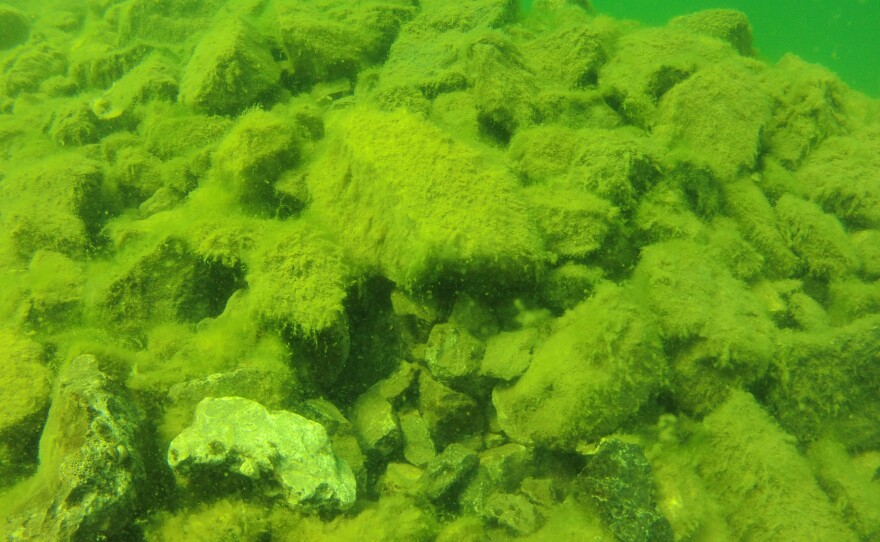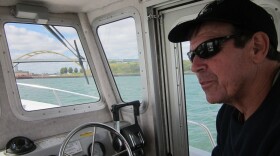A fish that was almost wiped out in the Great Lakes is making a comeback in Lake Huron.
Lake trout are suddenly doing what biologists have been trying to get them to do for more than 40 years: They’re making babies.
Lake trout used to be a mainstay of Great Lakes commercial fishing in the first half of the twentieth century. The Lakes would produce 15 million pounds of the fish every year.
Then the sea lamprey came in and sucked the life out of the lake trout populations.
Challenges to lake trout recovery
Jim Johnson never thought he’d see the day when lake trout recovered in Lake Huron. He runs the Department of Natural Resources research station in Alpena.
Johnson’s been working on the lake for 25 years and for most of that time it looked hopeless.
“I felt we were so completely stymied by one thing after another after another. The litany of challenges working against the reestablishment of a self-sustaining lake trout population seemed insurmountable,” Johnson said. “But then, with the collapse of alewives, everything changed.”
Alewives are a little feeder fish that come from the Atlantic Ocean.
When lake trout eat alewives, it causes all kinds of problems in eggs and young fish because of a vitamin deficiency.
The federal government has hatched almost 100 million lake trout since 1972 and put them in Lake Huron. But those stocked fish couldn’t reproduce, until the alewives disappeared.
That happened about ten years ago, mainly because there were too many salmon eating them. It doesn’t appear that alewives can ever recover.
Johnson says with the alewives gone, lake trout are now getting the nutrients they need, so they don’t need much more help from federal hatcheries.
A more stable ecosystem
The return of lake trout as the big predator might result in a more stable ecosystem.
In northern Lake Huron where we have so many young wild fish it seems redundant to be also stocking.
“Oh yes. The end of stocking is in sight for the main basin of Lake Huron,” Johnson said.
Lake trout arrived in the Great Lakes just after the glaciers receded and they adapted to cold and empty waters. They’re perfectly suited for the lakes.
In fact, the whole fish genus, salvelinus, is known for its adaptability.
“Even Darwin knew this group as a highly flexible group,” The University of Vermont’s Ellen Marsden said.
She says lake trout have a long lifespan and will search every corner of the lake for food. If there’s no food available they’ll just stop growing.
Marsden says there are lake trout in lakes in northern Canada that are vegetarians.
“The lake trout that we know and love, the big piscivorous and fast growing, there are also trout that are mature and could be 25 years old at half the size our lake trout are and they’re feeding on plankton,” Marsden said.
The prospect of lake trout returning to the top of the food web is an exciting one for scientists.
Lakes Michigan and Huron have been dominated by salmon from the Pacific Ocean for most of the last 50 years. They were introduced to create an exciting sport fishery.
But Jim Johnson says exotic salmon can’t adapt the way lake trout can and dramatic changes in Lake Huron’s ecosystem killed the salmon off.
“People tended to think of the Chinook (salmon) as an apex predator but they don’t meet these criteria of what an apex predator needs to do and that is to adapt to changing situations and still be there after a crisis,” Johnson said.
Johnson says native fish like lake trout and walleye are filling the void created by the salmon’s demise in Lake Huron.
http://www.youtube.com/watch?v=Ybs0tc_5050
He expects the lake to be a more stable ecosystem in the future, one that doesn’t need to be stocked with millions of hatchery fish every year.
Humans helping lake trout in other ways
Fishery managers aren’t stocking trout in Lake Huron, but they are still helping the fish.
Lake trout can spawn on reefs. Researchers working out of Alpena built a reef to help the lake trout reproduce naturally in Thunder Bay. The original reef was buried in kiln dust from a cement factory.
Support for the Environment Report comes in part from the Great Lakes Fishery Trust.















